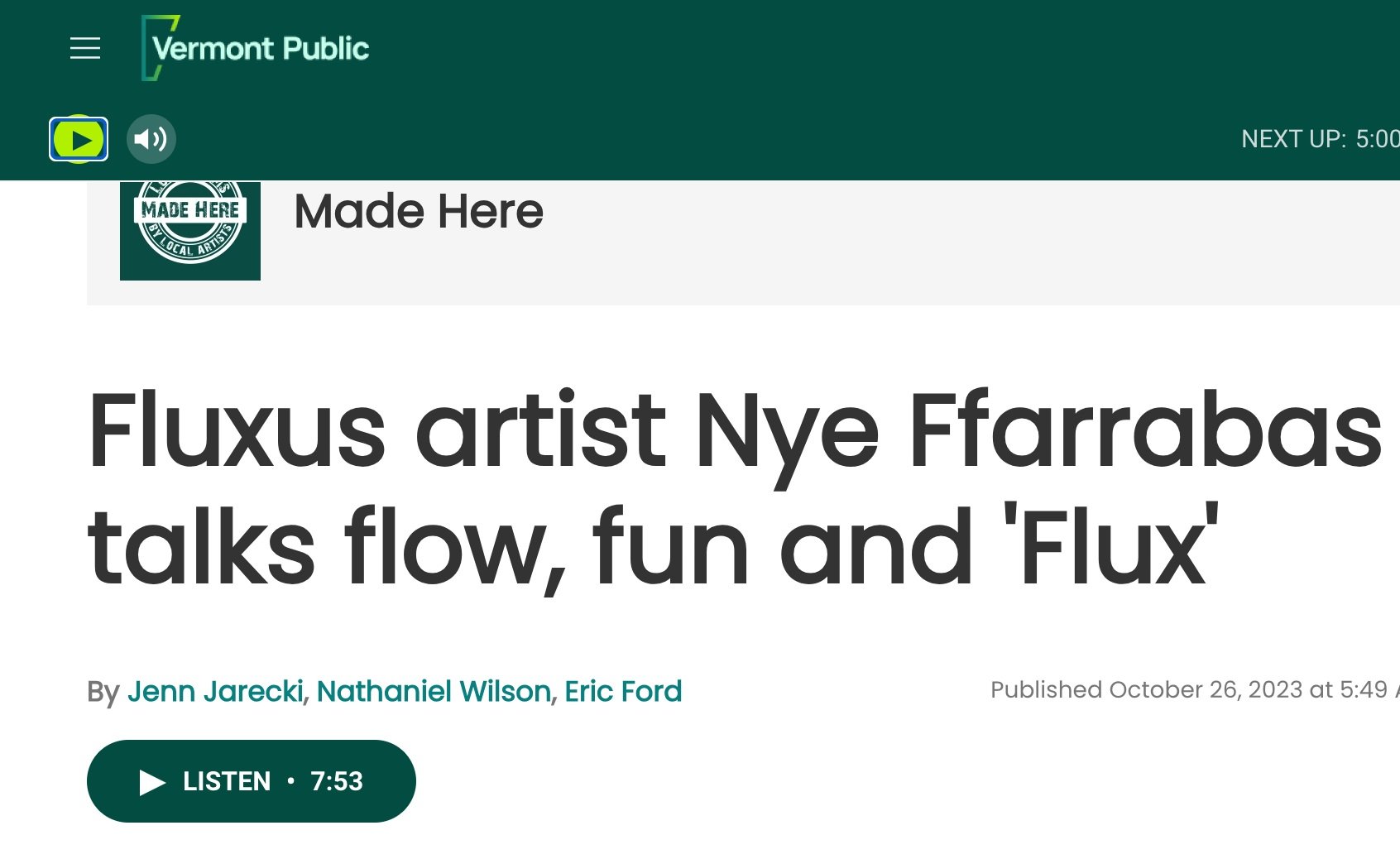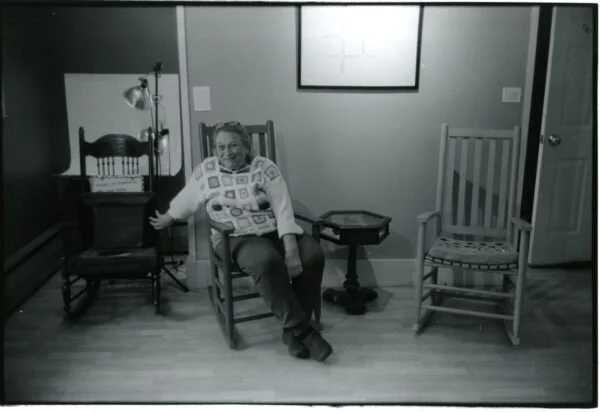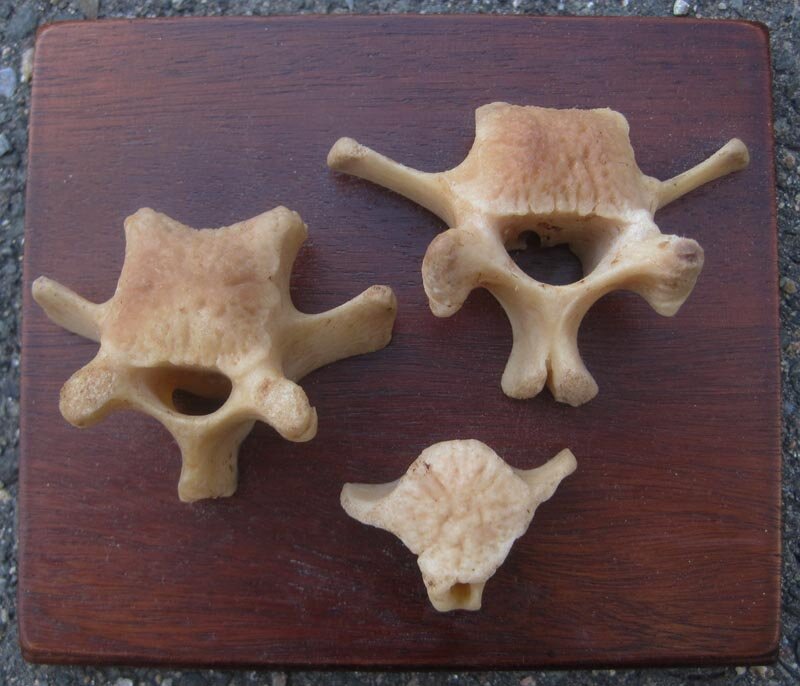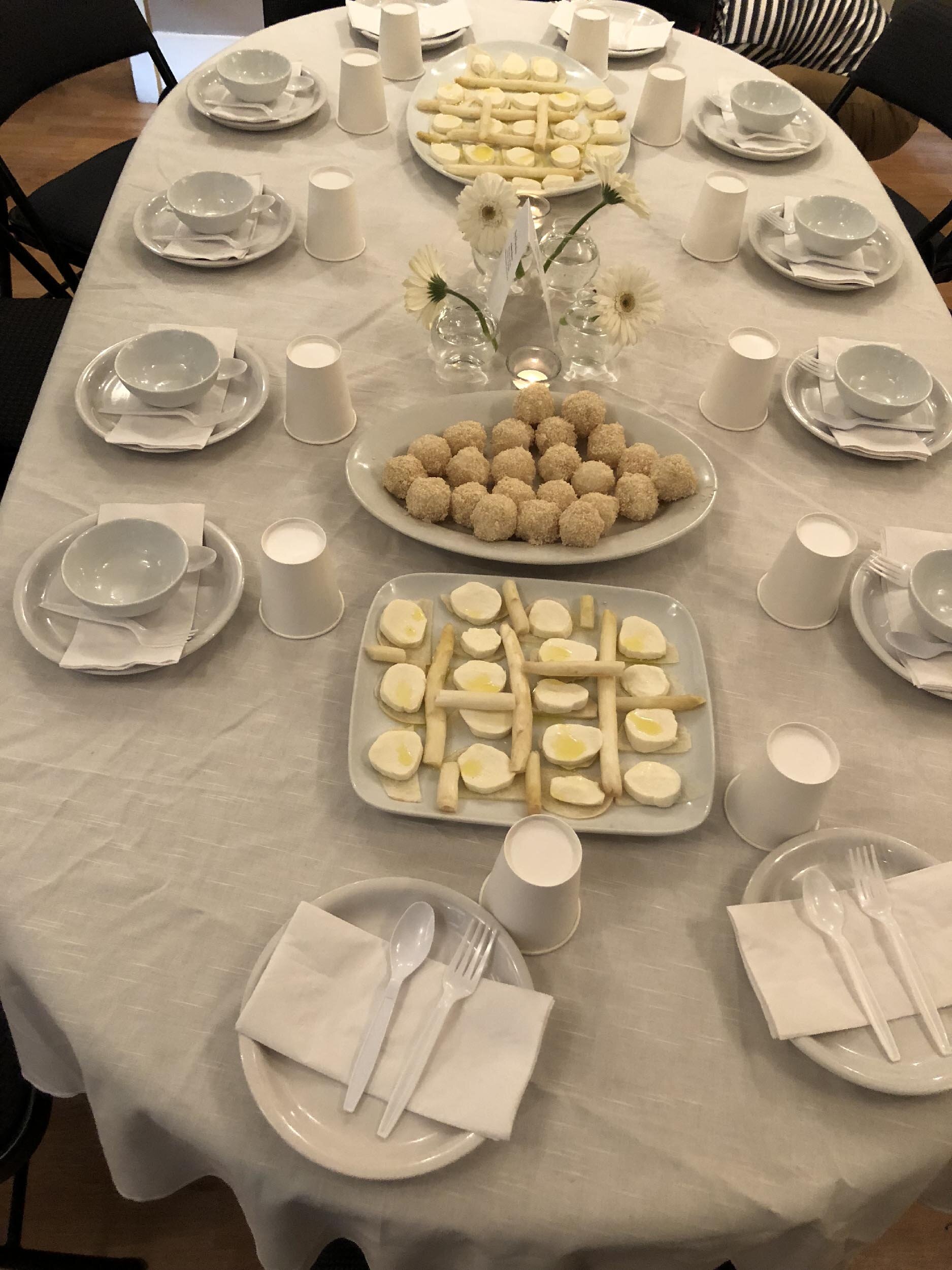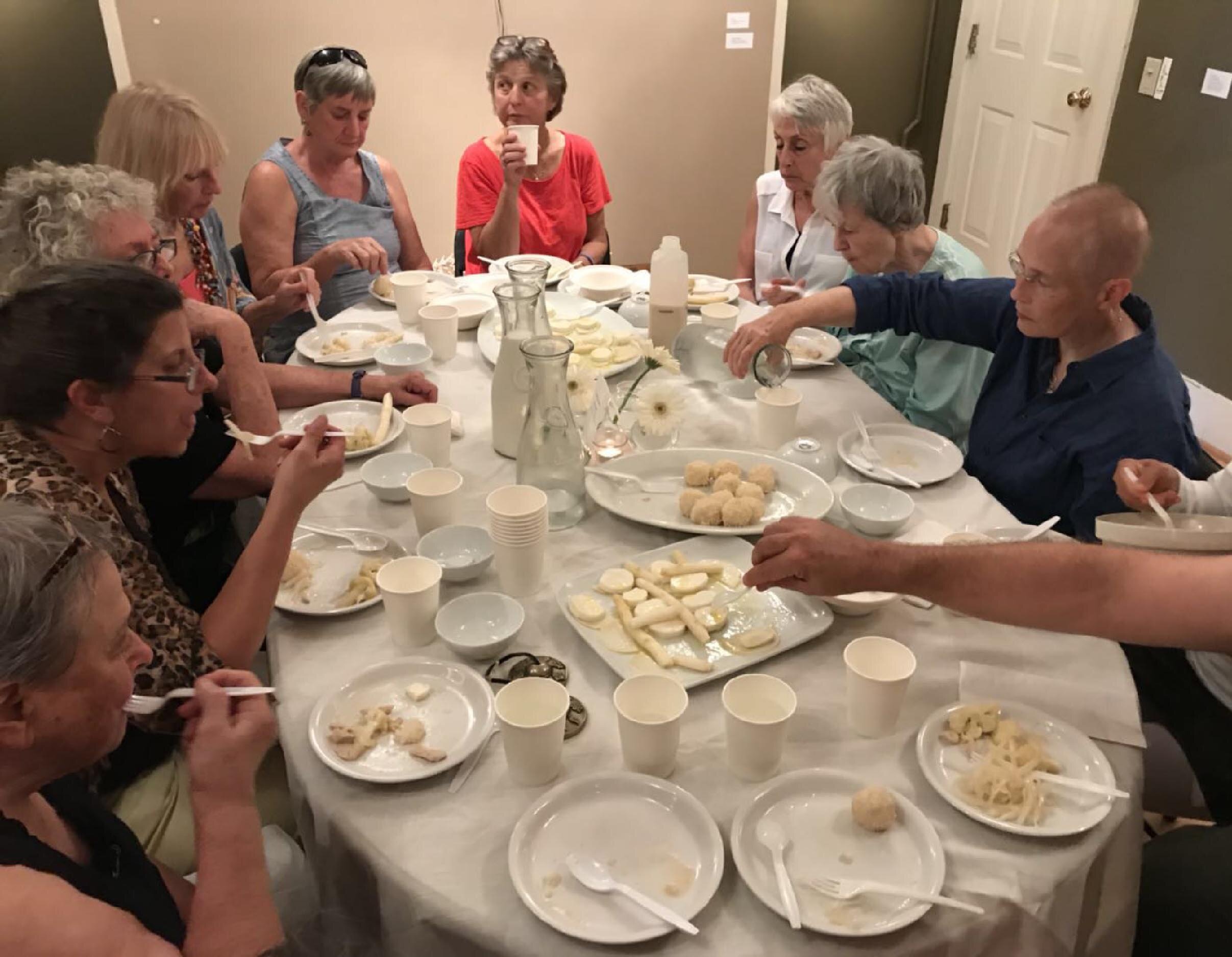
NYE FFARRABAS
At 92, Nye Ffarrabas, formerly Bici Forbes Hendricks, occupies a significant place not only in the postmodern art world but also in our global cultural zeitgeist. During the early and mid-1960s, she (as Bici) was part of New York City’s Fluxus community, an experimental and creative laboratory that viewed life and art as inseparable and, in some respects, one and the same.
“I think of Bici as a woman of vast courage, grace, and intelligence, whose contribution to Fluxus is now rightly celebrated historically with this retrospective.”
“The playful social, political and poetic sensibility evidenced in Nye’s work are what make it a standout.”
“In often playful and intimate work, we witness her grit, her endurance, and delight in the wicked turns of phrase, grounded deep in Yankee sensibility and generosity of spirit.”
Upcoming Events
Gallery Tour video of Nye/Bici’s 50-Year Retrospective:
Publications
-

A Pocketful of White Noise: A Cat Door In To The Friday Book
-

The Friday Book of White Noise
-

Nye Ffarrabas: A walk on the inside 50 year retrospective
I don't understand boring - Nye Ffarrabas in conversation with Lola Diaz Cantoni, 2017
Nye seems to me to occupy an ongoing, open-minded, creative state of surprise.” – Jacquelynn Baas. “Nye is a wordsmith, an alchemist with words.
— Geoffrey Hendricks (1932-2018).
Press
Image Gallery
details from Chair Piece
“In these activities she is present, present in the richest sense of truly Being-in-the-world in a way reserved for the blessedly fallen among us who are consciously in the world. She is here and there, then and now, encased in and free from her time.”
a silent dinner
Tuesday August 24, 2018. Performance piece by Nye Ffarrabas, a silent dinner, a new enactment of Nye’s event score / performance that was first composed in January 1966. The original set of instructions are detailed on page 44 of Nye’s book, a walk on the inside: 50-year retrospective (link to preview or purchase the book).
a silent dinner 2018 was a collaboration of Nye and Cai Xi with the assistance of Le Xi.
Fluxus artist Nye Ffarrabas (formerly Bici Forbes and Bici Hendricks) was a guest of honor and presented on her life work, her art of almost 60 years and her poetry and writing of almost 70 years, to a packed audience at the Hanze University graduate school of Academie Minerva (established in 1798) in the 900 year old city of Groningen in the Netherlands in October 2018 during the ARTisBOOK Week along with an exhibition of Fluxus Art from the archives of the Groninger Museum. This is the second of two parts of the proceeding where the audience asked questions and Nye responded and shared some of her poetry.
Poems and performance by Fluxus artist Nye Ffarrabas (formerly known as Bici Hendricks / Bici Forbes Hendricks), guest of honour during ARTisBOOK Week, Groningen, the Netherlands, from 13 to 20 October 2018.
May 4, 2014: Artist Nye Ffarrabas talks about her life and work at the CX Silver Gallery in Brattleboro on the occasion of the opening of her exhibition and book launch, a walk on the inside: 50-year retrospective Video produced by Brattleboro Community TV, videography by Clark Glennon.
Event Scores are scripts for activities. These can be instructions, proposals, or rhetorical questions as simple and enigmatic as single lines of text. Event scores are one form among many that Fluxus art can take. Fluxus, resisting formal definition and categorization, is a decentralized international community of visual and conceptual artists, poets, musicians, and performers. Fluxus events work across media, often text-based, with installations, performances, and sculpture that merge ‘art’ with ‘not art.’ Fluxus art sometimes involves concepts, sometimes things, and sometimes activities experienced by participants or observers.
WHAT IS THIS? Nye Ffarrabas, Perceptions on Music for 100 Years by Dr. Jane Alden, Wesleyan Professor of Music. Reprinted here online with permission from Nye Ffarrabas, The Friday Book of White Noise, Brattleboro, VT: C.X. Silver Gallery Press, 2023.
Starting in 1966, and responding to the revolutionary spirit of the time, Nye Ffarrabas used the format of an educational program, titled “Summer Institute of Human Relations – Extension Courses,” to set out a series of event scores, published by her Black Thumb Press. Richly varied, they include the invitation to circle around a pole, be a potato, swim in the sky, defrost the American flag, and think fast. Should such provocations be taken at face value? (If not, why not?) And how do they relate to other initiatives of their time?
The instructional material is arranged under three categories: “Elementary,” “Intermediate,” and “Advanced.” Only one instruction occurs under each heading in the primary course: “Practise saying ‘WHAT IS THIS?’.” At the Elementary level, the instruction continues, “until you have exhausted all possible ways of saying it”; this becomes, “until you have exhausted all possible answers”, at the Intermediate Level; and “until you have exhausted yourself”, at the Advanced Level. Each time, the instruction is followed by, “(Do not repeat yourself).”
Unlike other educational programs, the Black Thumb Summer Institute title page makes explicit that “No credit will be given or taken for participation in or performance of the present curriculum or any future supplement.” Rather than academic evaluation by external authorities, Nye’s Institute sought to cultivate evolution of the self. The repetition of “WHAT IS THIS?”, at each level, suggests that growth (and mastery of this and other curricula) comes from repeated questioning. The progression would be linear and experiential, not hierarchical. But Nye’s use of the terms Elementary, Intermediate, and Advanced itself invites reflection, and can be seen as a critique of social and educational stratification.
The 1960s is often represented as a time of rupture, renunciation, and rebirth. Long-established as the symbol of new life, the egg shape featured in many Space Age designs, including chairs by Arne Jacobsen and Peter Ghyczy and the optimistic Egg cinema by Joseph Philippe Karam in Beirut. These designs were probably influenced by the pod-like structures of space capsules, after Sputnik, but they also date back to ancient depictions of the cosmos as an egg, in Hindu, ancient Egyptian, West African Dogon, and ancient Greek mythology. In 12th-century Germany, the abbess, mystic, scientist, and composer Hildegard of Bingen had a vision of a cosmic egg, engulfed in flames, with what she called the “sandy globe” of Earth at the center of the stars.
From the cosmic to the organic, eggs are the origin of new life for most earthly creatures—an observation not lost on Nye Ffarrabas, who had both her children during the 1960s. In 1966, along with the Summer Institute of Human Relations Extension Courses, Nye published a “Supplement” that began with a “Milk Festival” followed by “Egg Watching.” In both, the temporal aspect is foregrounded. The Milk Festival unfolds over a week, with measuring activities assigned to each day. The sequence moves from commerce (buying milk) to reconstituting and diluting powdered, evaporated, and condensed milk, to expressing breast milk on day 6, and milking a cow on the 7th day. Each measure is a quart, but the implication is that the measurer is changed by the mode of access.
The time span for Egg Watching extends so far beyond a week that this piece has not yet been completed—indeed, we are only just over halfway through! For this event, Nye used the tiered system of the Summer Institute extension courses: the Elementary Level is to watch an egg boil for 4 minutes; the Intermediate Level involves watching the egg being fertilized, laid, and hatched; while the Advanced Level is to watch the egg become 100 years old.
The next instruction in the Supplement is to “Become Invisible.” It is possible to see these meditations on milk, eggs, measuring, watching, and disappearing as a poetic critique of domestic oblivion. The radicalism of the 1960s was not yet ready to recognize the work of the mother—as creator, feeder, and observer.
Nye Ffarrabas suggests that the way to achieve greater awareness is to begin with everyday activities and objects. In this regard, she follows in the footsteps of Marcel Duchamp, with his “readymades,” the meditative practices of the Eastern religions, and the blurring of boundaries between noise and music explored by John Cage, Pauline Oliveros, and other musical pioneers.
When Alison Knowles and Annea Lockwood prepared the self-published 1975 feminist publication Womens Work, they included a revised version of Nye’s Summer Institute program. Egg Watching was now categorized as an “INDEPENDENT STUDY” (for “ADDITIONAL CREDIT”). “WHAT IS THIS?” was not included. By 1975, different questions were being asked.
The publication of Womens Work (which also included works by 24 other artists, composers, and choreographers) brought Nye’s work to a new public—an expansion magnified in 2019, when the book was reprinted in a faithful facsimile edition by Primary Information (1500 copies). The Womens Work cover resembles a metal tin plate with eight pre-drilled holes for mounting. Referencing construction signage denoting “men at work,” the typographic inspiration for this cover could also have been the rustic metal signs with pre-drilled holes that were used for hanging farm notices advertising “Fresh eggs for sale,” and other farmstead products. The inclusion of Egg Watching in this volume adds further depth to Ffarrabas’s use of agricultural produce to assist in the cultivation of sensory awareness.
To celebrate Nye’s 90th birthday in 2022, I performed three of her 1960s event scores - “WHAT IS THIS?”, “Egg Watching”, and “Paper Concerto” - alongside four original rounds Nye composed during later decades. Juxtaposition and overlap are techniques I use as invitations for audiences to observe relationships between pieces. Nonlinear presentation also draws attention to the ephemerality of the present moment, which seemed appropriate when featuring a piece intended to last 100 years. We had our Egg Watcher on stage before the show began, with a large papier-maché egg he had prepared for the occasion. He annotated the egg throughout the performance, and remained on stage afterwards, as the activity of Egg Watching must continue into the future.
Taking place in Pentameters Theatre, London, the performance was called Scratch and the Sequence, in homage to the Scratch Orchestra, founded in 1969 by Cornelius Cardew, Michael Parsons, and Howard Skempton. In the first Scratch Orchestra publication, Nature Study Notes (1969), Cardew had included Parsons' Egg-pushing Rite, an improvisation exercise which drew on the long tradition of ‘egg and spoon’ races. Across the Atlantic, and just a few years after Nye first published her Egg Watching, experimental musicians were undertaking similarly ovate explorations.
The 2022 program began with Cardew’s 1968 opera book, Schooltime Compositions which he had prepared in an American composition book, just like The Friday Book of White Noise collection, then already underway. My group, the Vocal Constructivists, found a similar embrace of the everyday in Christian Wolff’s 1973 Sticks, “for sticks of various kinds.” And in Alvin Lucier’s 1997 Opera with Objects, pairs of pencils serve to reveal the acoustic properties of household objects. Lucier’s instructions - that performers “make vivid for listeners the natural amplification inherent in physical things” - could apply equally to Nye’s focus on ordinary, overlooked, or discarded objects, many of which she shows to reveal profound, existential truths.





